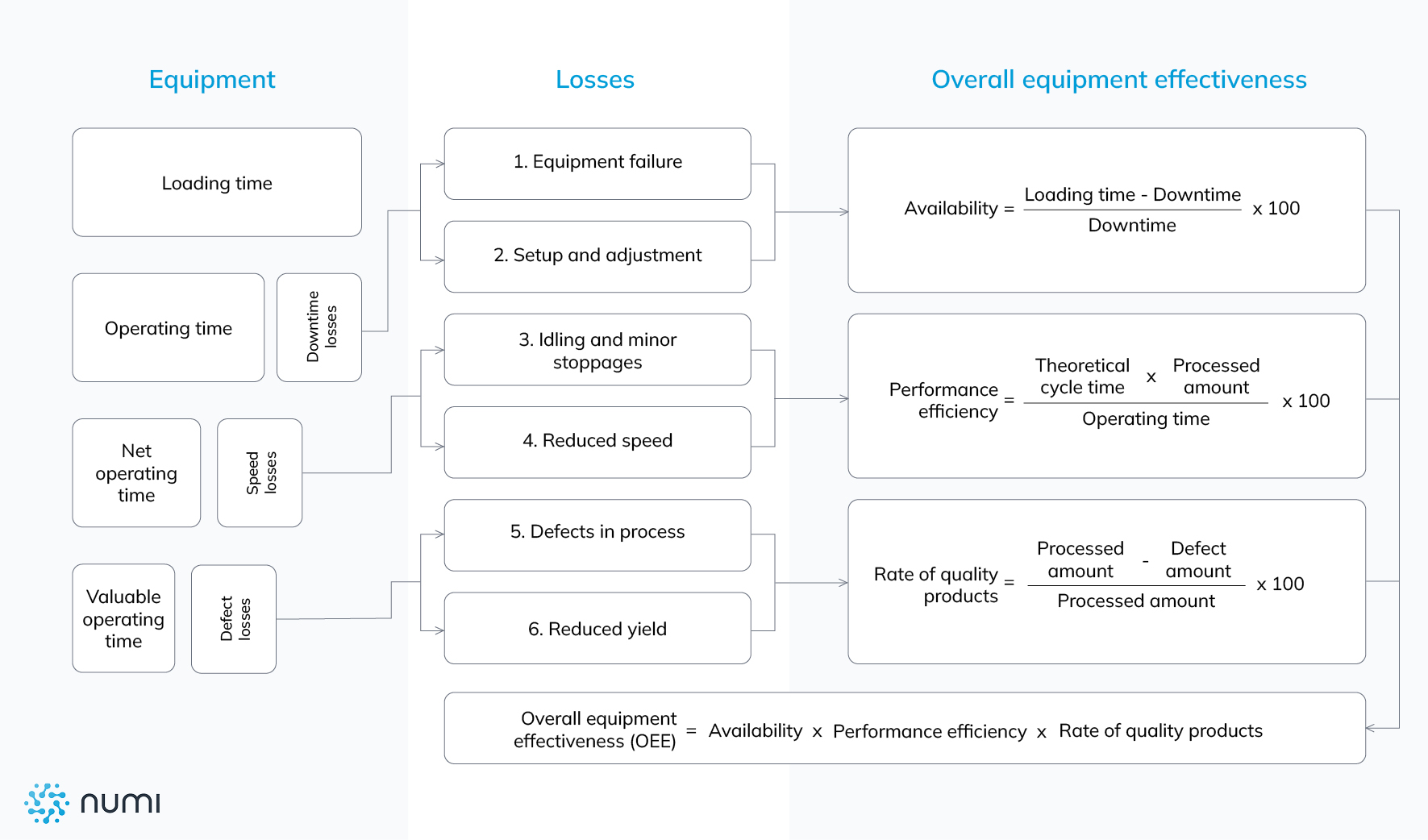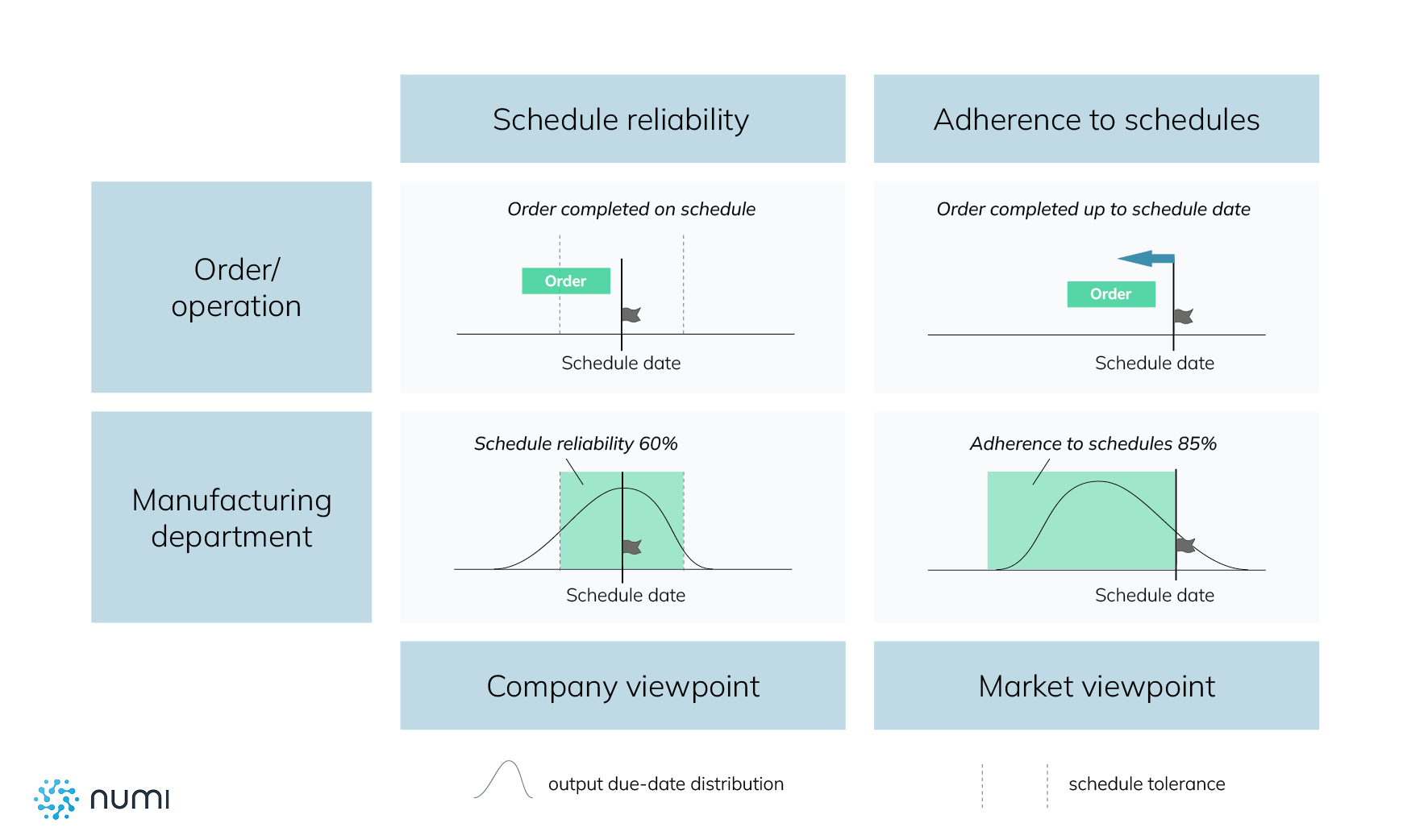
Production KPIs for success: OEE in production planning

Yulia Fedorova
31 Oct 2024
To remain viable in the highly competitive and rapidly advancing manufacturing industry, businesses must continuously strive for higher levels of efficiency, precision, and output. Amid the technological evolution and increasing complexity of production environments, effective management and optimization of manufacturing processes are paramount. This is where Production KPIs play a pivotal role, serving as the backbone for data-driven decision-making, process improvement, and overall operational success.
Production KPIs are quantifiable metrics used to evaluate the performance of production processes. They provide essential insights across various dimensions, such as machine utilization, production timelines, resource consumption, and quality control. With modern production systems operating in real-time, these KPIs act as a critical feedback mechanism, highlighting the current state of operations while identifying areas for improvement.
What sets production KPIs apart is their ability to deliver actionable data in an ever-changing environment. By continuously tracking these metrics, manufacturers gain a clear understanding of how each element of their production line contributes to overall performance. They can monitor the health of equipment, detect inefficiencies in the workflow, and measure output quality, all while ensuring that safety protocols are upheld.
However, the importance of production KPIs extends beyond operational oversight. These metrics form the foundation of strategic planning and optimization. By identifying and analyzing bottlenecks, delays, and inefficiencies, production KPIs empower companies to fine-tune their processes. Production KPIs offer several strategic benefits that go beyond day-to-day operational insights:
- Enhanced decision-making: Real-time KPIs like OEE and cycle time enable leaders to make data-driven decisions, boosting competitiveness and minimizing downtime for long-term market agility.
- Optimized resource allocation: Tracking labor productivity and material usage helps align resources with strategic goals, maximizin output and minimizing waste for sustainable growth.
- Cost reduction: KPIs like cost per unit and scrap rate highlight inefficiencies, allowing businesses to cut costs and improve margins, strengthening financial health.
- Increased efficiency: Monitoring bottleneck KPIs improves production flow and reduces lead times, positioning companies for greater market responsiveness and operational excellence.
- Continuous improvement: Defect rates and first-pass yield foster a culture of ongoing process optimization, aligning with Lean principles for long-term quality and performance gains.
Types of production KPIs
Different production KPIs serve distinct purposes, helping manufacturers track performance in various areas such as efficiency, timeliness, cost, quality, and safety. Each KPI offers a unique lens through which companies can assess their production health, from equipment usage to adherence to schedules. Let’s examine the main types:
Equipment and process efficiency KPIs
These KPIs focus on the performance, availability, and efficiency of equipment and production processes.
- Overall Equipment Effectiveness (OEE): Evaluates the efficiency of equipment by considering availability, performance, and quality.
- Machine Downtime: Monitors the amount of inactive machine time due to breakdowns or maintenance.
- Cycle Time: Measures how long it takes to produce a single unit, reflecting production speed and efficiency.
- Throughput: Assesses the total number of units produced within a specific time period, indicating the capacity of the production line.
Production scheduling and timeliness KPIs
These KPIs assess how well production adheres to schedules and meets deadlines.
- Production Schedule Adherence: Measures how closely production adheres to the planned schedule, tracking whether production targets are met on time.
- Production Order Delay Index: Tracks the overall delay of production orders by calculating the average delay time compared to the original scheduled completion date, providing insights into production timeliness.
Quality KPIs
Quality control is central to ensuring that products meet customer expectations.
- First Pass Yield (FPY): The percentage of products that are manufactured correctly without the need for rework. A high FPY indicates efficient production and reduced waste.
- Defects per Unit (DPU): Provides insight into product quality by calculating the number of defects present in a unit.
- Customer Reject Rate: A key indicator of customer satisfaction, this KPI reflects the percentage of products returned by customers due to defects.
Cost KPIs
These KPIs focus on tracking the costs involved in production processes.
- Cost per Unit: Calculates the total cost of producing a single unit, including materials,labor, and overhead. Understanding CPU is vital for setting competitive prices.
- Downtime Cost: Calculates the cost associated with unplanned production stoppages due to machine breakdowns, maintenance, or other delays. Downtime costs include lost production,labor, and potential customer penalties.
- Scrap Rate: Monitors the financial impact of defective products or wasted materials that need to be scrapped or reworked. High scrap or rework costs indicate inefficiencies in the production process.
Safety KPIs
Safety KPIs ensure that a company's workforce remains protected and that workplace incidents are minimized.
- Incident Rate: Reflects the number of accidents or safety violations that occur in a manufacturing facility. A lower rate indicates a safer environment.
- Lost Time Injury Rate (LTIR): Tracks how many injuries cause employees to miss work, an important measure for assessing workplace safety and morale.
Equipment, timeliness and process efficiency KPIs
At numi, our focus on enhancing operational efficiency makes KPIs an integral part of our supply chain software solutions. By closely monitoring and analyzing KPIs such as OEE, Cycle Time, Production Schedule Adherence, and Production Order Delay, we empower manufacturers to optimize their processes, reduce costs, and improve overall productivity. Let’s delve deeper into these critical KPIs.
Overall Equipment Effectiveness (OEE)
Definition: OEE is a comprehensive metric that evaluates the efficiency of manufacturing equipment. It combines three key components: availability, performance, and quality. Availability measures the proportion of scheduled time that production equipment is available for use, performance assesses the speed of production relative to its maximum potential, and quality indicates the percentage of products produced without defects.
Importance: OEE is essential for identifying the effectiveness of manufacturing operations. A high OEE score indicates that equipment is being utilized efficiently, while a low score highlights areas for improvement. By focusing on OEE, manufacturers can maximize their equipment utilization and enhance overall productivity.

- Planned production time: Total time scheduled for production.
- Downtime: The time when the equipment is not operational due to breakdowns or maintenance.
- Total units produced: The number of units completed in the scheduled time.
- Ideal cycle time: The fastest possible time to produce one unit.
- Defective units: The number of units produced that do not meet quality standards.
Cycle Time
Definition: Cycle time is the total time taken to produce a single unit from start to finish. It includes all phases of production, from the initial setup to the completion of the product, encompassing both active and inactive time.
Importance: Understanding cycle time is crucial for identifying bottlenecks in the production process. A shorter cycle time typically translates to higher production capacity and responsiveness to market demand. Monitoring this KPI allows manufacturers to streamline processes, improve throughput, and enhance customer satisfaction by delivering products faster.

- Total production time: The cumulative time taken to produce a batch of units.
- Number of units produced: The total count of units completed during that time frame.
Production Schedule Adherence
Definition: Production schedule adherence measures how closely production aligns with the planned schedule. It indicates the percentage of production targets that are met within the designated time frame.
Importance: This KPI is vital for assessing the reliability of production processes. High adherence rates signal that operations are running smoothly and efficiently, while low adherence can indicate scheduling issues, resource constraints, or unexpected delays. Monitoring this KPI enables manufacturers to improve planning accuracy and enhance operational responsiveness.
Data required:
- Planned production volume: The number of units scheduled for production.
- Actual production volume: The number of units produced within the scheduled time.

Schedule reliability, from a company’s viewpoint, is about completing orders precisely on time—neither
early nor late—as this is economically beneficial. This reliability also influences the efficiency of
the production process. To define schedule reliability, companies set a time buffer, or schedule tolerance,
around the target date, where orders completed within this buffer are considered on time. This buffer may
be symmetrical around the target date or have more leeway on one side than the other. The factors affecting
schedule reliability include how close the average completion date is to the target date, along with the
width of both the schedule tolerance and the range of actual completion dates. From a market perspective,
only late orders affect adherence to schedules, which is a measure of how well companies meet promised
dates for customers. This measure, used in production control, indicates customer satisfaction regarding
delivery timelines. Reliable scheduling in each stage of production also reduces the chance of delays throughout
the entire order process, ultimately minimizing customer delivery deviations.
Production Order Delay
Definition: The production order delay KPI tracks the overall delay of production orders by calculating the average delay time compared to the original scheduled completion date. This KPI provides insights into the timeliness of order fulfillment and production efficiency.
Importance: Monitoring production order delay is crucial for identifying trends in production efficiency and order management. By understanding the reasons behind delays, manufacturers can implement corrective actions to minimize disruptions, improve lead times, and enhance customer satisfaction.
Data required:
- Scheduled completion date: The planned date for completing a production order.
- Actual completion date: The date when the production order was actually completed.
- Total number of orders: The count of production orders being tracked for delay analysis.
Challenges in maintaining production KPIs
While production KPIs are essential for optimizing manufacturing operations, their implementation comes with several challenges. One major issue is ensuring data accuracy and completeness. In many cases, companies still rely on manual data entry, which introduces the risk of human error and inconsistency. Inaccurate or incomplete data can distort KPI results, making it difficult for managers to make informed decisions. To mitigate this, it’s critical to move toward real-time, automated data collection that ensures accuracy and validity for consistent KPI reporting.
Another significant challenge is system integration. Modern manufacturing environments often operate with multiple, disconnected systems across departments, including ERP, MES, and inventory management software. Consolidating data from these systems into a single, unified platform for KPI tracking can be resource-intensive. Legacy systems in particular may not be equipped to handle the demands of modern data processing, making it difficult for businesses to achieve a seamless integration that provides a comprehensive view of production performance.
In addition, there’s the risk of KPI overload. With the vast amount of data available today, it’s tempting to monitor too many KPIs, leading to information overload. When too many metrics are tracked, it can become unclear which ones are the most important to act upon. This can confuse decision-makers and dilute the impact of the insights that KPIs are designed to provide. To avoid this, it’s essential for companies to focus on a select few KPIs that offer the most valuable and actionable insights into production performance.
Adapting to changing metrics presents its own set of challenges. As production processes evolve with the introduction of new technologies and shifting business objectives, KPIs must be adjusted to remain relevant. However, this adjustment can be difficult, especially if teams are resistant to change or accustomed to outdated benchmarks. Ensuring that KPIs evolve in line with business goals requires a dynamic approach and strong communication to keep teams aligned with new targets and expectations.